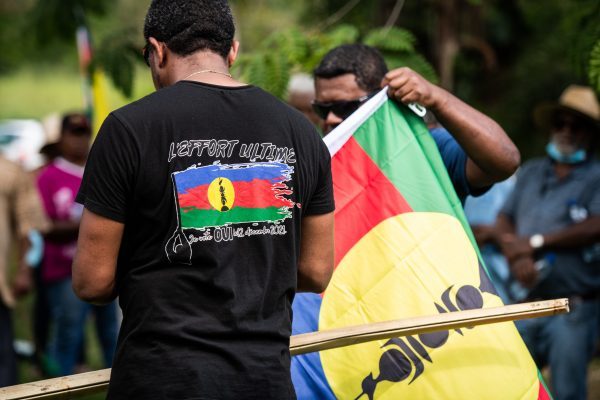2021 in the Pacific

In 2021, the Pacific Islands saw dramatic change with the threatened exit of Micronesian states from the Pacific Islands Forum and the fall of the region’s longest serving political leader, former Samoan prime minister Tuilaepa Sailele Malielegaoi. But in these and other major events we see echoes of the past and threads of continuity in Pacific politics and international relations.
In February, the Pacific Islands Forum broke apart over the controversial election of former Cook Islands Prime Minister Henry Puna as the next Secretary-General, by one vote, over the Micronesian candidate, Gerald Zackios.
Five Micronesian states — Federated States of Micronesia, Kiribati, Marshall Islands, Nauru and Palau — announced they would leave the Forum over what they saw as a breach of a ‘gentleman’s agreement’ to rotate the position of Secretary-General between the three sub-regions. While ‘Micronexit’ is far from confirmed as negotiations continue, a leaders meeting in September made the rift clear when most Micronesian states boycotted.
This represents an existential threat to the Forum’s relevance. One that — despite threats from the Micronesian states in the lead-up to the vote — took observers by surprise. Yet this grievance is rooted in a long history of perceived North Pacific marginalisation within what was originally called the South Pacific Forum.
It intersected with other regional tensions, including a conflict over governance of the University of the South Pacific that saw Vice-Chancellor Pal Ahluwalia expelled from Fiji amidst outcry. Whether Micronesia stays or goes, there is work to be done in regaining a sense of pan-Pacific solidarity at the state level.
Samoa’s election in April produced an unexpected result: the prospect of a hung parliament after Tuilaepa, the second longest-serving prime minister in the world, and his Human Rights Protection Party (HRPP) had dominated for decades. A new opposition party, Fa’atuatua i le Atua Samoa ua Tasi (FAST), led by popular politician Fiame Naomi Mata’afa, produced a shock upset at the polls.
After months of political wrangling and legal challenges, Fiame was finally confirmed as Samoa’s first woman prime minister in July.
Long known for its political stability, the turmoil in Samoa became the year’s biggest Pacific news story. Yet keen observers noted the similarity between the events of 2021 and those of 1982, when the HRPP first took power. It remains to be seen how big of a shift in Samoan politics FAST represents, although the leadership of Fiame — a long time HRPP MP and cabinet minister, who was deputy prime minister until 2020 — suggests there will be some policy continuity.
COP26, the United Nations climate change conference, was finally held in Glasgow late last year. The pandemic created issues for Pacific negotiators, preventing many regional leaders, diplomats and technical experts from travelling to the conference. The result was hailed by some as progress, but many expressed disappointment at watered-down language on coal and a lack of action on the Pacific’s push for funding for loss and damage.
COP26 seemed to end as many of its predecessors have: with Pacific negotiators making an impact, but the rest of the world falling short on firm commitments.
In November, discontent in Solomon Islands boiled over into riots in the capital, Honiara. The Solomon Islands government requested assistance from Australia, which quickly responded. Papua New Guinea, Fiji and New Zealand also provided security support in an operation reminiscent of the beginnings of the Regional Assistance Mission to Solomon Islands.
The tensions prompted a vote of no confidence in the nation’s parliament, easily defeated by the government led by Manasseh Sogavare. Currently in his fourth stint as prime minister, Sogavare is seen by many as representing a lack of progress in Solomon Islands politics.
A third New Caledonian independence referendum returned a result favouring staying with France. But unlike the results in 2018 and 2020 — 57 per cent and 53 per cent respectively — the 2021 poll saw 96 per cent of voters rejecting independence.
The drastic change was due to a pro-independence boycott after calls to postpone the referendum because of a COVID-19 outbreak went unheeded by French authorities. Pro-independence leaders indicated they will not participate in any post-referendum negotiations before 2022’s French presidential election. The referendum thus concludes with no clear answers, a deeply divided electorate and uncertainty on New Caledonia’s future status.
Throughout 2021, the effects of COVID-19 were felt in the region, with large outbreaks in Fiji, Papua New Guinea, French Polynesia, Guam and New Caledonia. Even for countries that had very few cases, the economic impacts have been devastating. Vaccine rollouts had mixed results, with vaccination rates ranging from 3 per cent in Papua New Guinea to 99 per cent in Palau.
One notable theme in evaluating the year’s events in the Pacific Islands is an unanticipated impact of the COVID-19 pandemic: the localisation of news reporting. Border closures have restricted the ability of foreign journalists to travel to the region to cover big news stories. Local journalists have stepped up to bring Pacific news to international audiences. This is part of the broader story of localisation that has been a by-product of COVID-19 border closures. In this case, at least, change is clear.
This article was published by the East Asia Forum.
Kerryn Baker is a Research Fellow in Pacific Politics with the Department of Pacific Affairs, The Australian National University. Her book Pacific Women in Politics: Gender Quota Campaigns in the Pacific Islands was published in April 2019.












